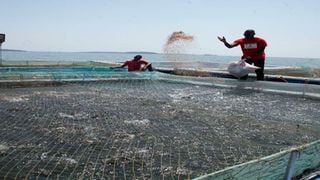
Shelton Omollo feeds his fish in Ogal beach, Lake Victoria. He advises those interested in cage fish farming to get advice from experts.
Seeds of Gold
Premium
When cage fish farming pays bills
What you need to know:
- Shelton Omollo wants the government to lower taxes on feeds to encourage others venture into fish farming.
- He also wants authorities to reduce the cost of acquiring key permits.
We are at Ogal Beach, almost 25 kilometres from Kisumu City centre. It has taken approximately 45 minutes to reach the beach.
One would expect a beehive of activities on the beach. On the contrary, very little seems to be happening here.
Ogal beach is dominated by scattered fish cages.
We come across Shelton Omollo, a cage fish farmer.
The father of two started this kind of farming in December 2019 after quitting his job as a clerk at a clearing and forwarding company in Mombasa.
Omollo says he was inspired by success stories of fish cage owners in Ogal.
“I came back home from the Coast and felt I just did not want to work under other people. I wanted to be my own boss. Having witnessed what cage fish farming could do, I was challenged to venture in aquaculture,” the 30-year-old farmer told Seeds of Gold.
With Sh200,000 from his savings, Omollo engaged a local welder to make a cage.
He started with one metallic cage that measured six metres by six metres by four metres.
He stocked the cage with 5,000 tilapia fingerlings bought from Pioneer Fish Farm in Maseno town. One fingerling cost him Sh4.
Having quality feed is necessary for the growth of fish.
Omollo spent Sh60,000 on eighteen 25-kilogramme bags of feed, which he got from Kenya Marine and Fisheries Research Institute (KMFRI).
“We did not have a boat in the beginning. We had to hire one from Ogal beach fishermen to access the cage daily,” Omollo, who feeds his fish twice a day, says.
Six months after the fingerlings were introduced in the cage, Omollo made his first harvest.
He says it was a disappointing start since most fish did not have the right weight.
A majority weighed between 300 to 600 grammes.
From that first yield, Omollo learnt a lot from his mistakes.
“I ventured into aquaculture without any formal training. Later, experts informed me that the fish were underweight because I had overstocked the cage. With that knowledge, I scaled down to 4,000 fingerlings,” he says.
Omollo adds that he also learnt that it is important to buy quality young fish for better yields.
“Some hatcheries hide critical information from buyers. Because of this, many farmers end up having poor quality fingerlings. There are hatcheries that sell mixed sex fingerlings instead of mono sex,” he says.
Safina Musa, a researcher at KMFRI, Kisii station, says a farmer should stock just enough fingerlings to give the fish space and time to grow.
He also advises fish farmers to use quality feeds and ensure the water is of high quality.
“We advise farmers to stock fingerlings properly. With that, they should harvest 80 kilogrammes per cubic metre square,” the researcher says.
Musa adds that if the objective is to have bigger fish weighing half a kilogramme or more, the farmer should stock less fingerlings to avoid stress and competition for food.
Having learnt from his mistakes, Omollo made use of the advice from experts to improve his yields.
Today, the farmer has a wooden boat powered by a petrol engine.
The vessel enables him, his workers and other interested parties to get to the cages easily.
“We ensure the fish get quality commercial feeds twice a day,” Mr Omollo says.
The farmer has installed solar lighting around his nine cages and even hired people to patrol the area at night.
“We are soon installing security cameras around the cages. We need to monitor any movement and activities around,” he says.
He stocks a cage with at least 4,000 fingers and harvests after every two months.
The price of fish is determined by weight.
A fish that weighs 210 to 330 grammes goes for Sh270, while one that is 331 to 440g costs Sh300.
A fish that is 441g to 550g costs sh340 and that above 551g is sold for 360.
Omollo mainly sells his produce to fishmongers in Ogal beach, hotels, restaurants and online customers.
“Initially, I supplied fish to hotels in Kisumu but stopped because some refused to pay. I resorted to work with fishmongers as they ordinarily make payment within three days,” Omollo says.
The farmer says he can make up to Sh350,000 from his fish in a good month.
According to Omollo, the biggest challenge facing fish farmers is expensive feeds. He says even getting the costly feeds becomes a problem at times.
“I appeal to the government to lower tax on imported feeds as this will make fish farming affordable and sustainable,” Omollo says.
He wants concerned state and county authorities to give farmers unified certification.
“For one to engage in such business, he must get permits from the Kenya Environment Management Authority, KMFRI and other agencies. Getting these permits is very cumbersome and expensive,” Omollo says.
What are his plans?
“I intend to expand the business by increase the number of cages,” the farmer says.





